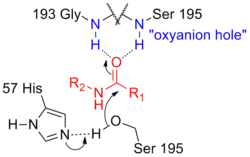Oxyanion hole
An oxyanion hole is a pocket in the active site of an enzyme that stabilizes transition state negative charge on a deprotonated oxygen or alkoxide.[1] The pocket typically consists of backbone amides or positively charged residues. Stabilising the transition state lowers the activation energy necessary for the reaction, and so promotes catalysis.[2] For example, proteases such as chymotrypsin contain an oxyanion hole to stabilise the tetrahedral intermediate anion formed during proteolysis and protects substrate's negatively charged oxygen from water molecules.[3] Additionally, it may allow for insertion or positioning of a substrate, which would suffer from steric hindrance if it could not occupy the hole (such as BPG in hemoglobin). Enzymes that catalyse multi-step reactions can have multiple oxyanion holes that stabilise different transition states in the reaction.[4]

References
- Stryer L, Berg JM, Tymoczko JL (2002). "9 Catalytic Strategies". Biochemistry (5th ed.). San Francisco: W.H. Freeman. ISBN 978-0-7167-4955-4.
- Simón, Luis; Goodman, Jonathan M. (March 19, 2010). "Enzyme Catalysis by Hydrogen Bonds: The Balance between Transition State Binding and Substrate Binding in Oxyanion Holes". The Journal of Organic Chemistry. 75 (6): 1831–1840. doi:10.1021/jo901503d. ISSN 0022-3263. PMID 20039621.
- Ménard, Robert; Storer, Andrew C. (1992). "Oxyanion Hole Interactions in Serine and Cysteine Proteases". Biological Chemistry Hoppe-Seyler. 373 (2): 393–400. doi:10.1515/bchm3.1992.373.2.393. PMID 1387535.
- Kursula, Petri; Ojala, Juha; Lambeir, Anne-Marie; Wierenga, Rik K. (December 1, 2002). "The Catalytic Cycle of Biosynthetic Thiolase: A Conformational Journey of an Acetyl Group through Four Binding Modes and Two Oxyanion Holes‡". Biochemistry. 41 (52): 15543–15556. doi:10.1021/bi0266232. ISSN 0006-2960. PMID 12501183.
- Albert Lehninger; et al. (2008). Principles of Biochemistry (5th ed.). Macmillan. p. 207. ISBN 9780716771081.